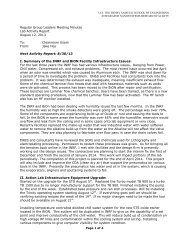Download Lab Safety Manual - Integrated Nanosystems Research ...
Download Lab Safety Manual - Integrated Nanosystems Research ...
Download Lab Safety Manual - Integrated Nanosystems Research ...
Create successful ePaper yourself
Turn your PDF publications into a flip-book with our unique Google optimized e-Paper software.
disposal cost in California is high and everyone bears the economic and environmental burden; please try to<br />
minimize waste generated.<br />
There are two ways of disposing of liquid chemical waste. The required method for disposal depends on the kind<br />
of chemical waste generated:<br />
1. Local solvent collection tank;<br />
2. Local bottle collection.<br />
These are the five general kinds of liquid chemical waste, with different methods of disposal:<br />
1. Standard inorganic acids and bases (local collection)<br />
2. Fluorine-containing acid mixtures (local collection)<br />
3. Solutions containing heavy metals (i.e. metal etchants) or other hazardous materials (local<br />
collection)<br />
4. Standard solvents (solvent collection tank)<br />
5. Halogenated solvents (local collection; where possible, separate from nonhalogenated solvents)<br />
Details procedures on how to dispose of chemical waste are found in the standard operating procedures for the<br />
specific chemical processing wet benches. A general description of the chemical waste disposal systems and<br />
methods follows.<br />
The Acid Waste Collection – Standard inorganic acids and bases are collected at the individual acid wet benches<br />
in labeled collection bottles (see SOP for)<br />
HF Waste Collection – High concentrations of fluorine ions are an extreme health hazard. Therefore, fluorideion-containing<br />
solutions must be disposed of separately from other waste, using the HF approved containers.<br />
These solutions include hydrofluoric acid, buffered oxide etchants (BOE’s) ammonium fluoride, and any mixtures<br />
thereof. Waste from the HF containers is collected and relocated outside the lab, and is regularly removed for<br />
disposal by a local service provider.<br />
Standard wet benches and at non-standard processing wet benches HF and BOE waste must be manually poured<br />
into the specially marked HF approved containers. These mixtures must NOT be aspirated nor poured down any<br />
other drains. If this is done accidentally, notify a lab staff member immediately.<br />
Solvent Waste Collection Containers – Standard, non-halogenated solvent waste is collected into containers at the<br />
solvent wet benches. The standard solvents are: methanol, isopropanol, and acetone. Standard solvent waste<br />
includes these chemicals and associated photoresist waste. Do not put halogenated, organic waste into the Solvent<br />
waste collection container. (See below).<br />
Local Collection – All chemicals used at INRF/BiON are disposed of using general waste collection containers or<br />
bottle and are finally disposed through EH&S. Halogenated organic solvents pose special health and<br />
environmental risks for disposal, and so, must be collected, located, and separated from other kinds of waste.<br />
(Halogens are: chlorine, fluorine, bromine, iodine, and astatine.) The inorganic acids, such as hydrochloric acid,<br />
hydrogen fluoride or hydrofluoric acid, are not included in this category. Halogenated organics are discouraged<br />
from use in the lab and some are banned. Examples include chlorobenzene, TCE, borothene, and carbon<br />
tetrachloride.<br />
Halogenated organic waste must be treated by incineration at higher temperatures than for other wastes, to prevent<br />
the possible formation of highly toxic compounds such as PCB’s and dioxin. So please separate and properly<br />
label any halogenated waste from other solvent waste.<br />
Any waste containing toxics, heavy metals, or any chemicals must NOT be disposed of in the city waste treatment<br />
center and so must be collected locally. The most common source of metal ions in the lab is in used metal<br />
etchants (including gold and chrome etchants). These solutions must absolutely not be aspirated or poured down<br />
any drain; they must be collected in waste containers and sent out for hazardous waste disposal. Prohibited<br />
heavy metals and other toxics include, but are not limited to, the following:<br />
15



